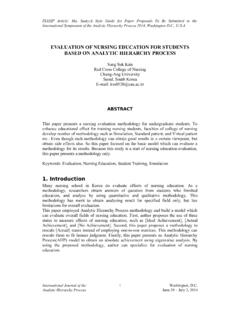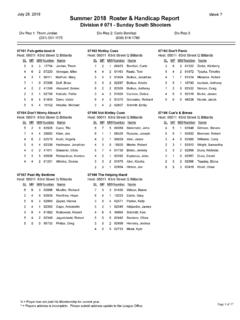Transcription of A NEW METHOD OF JOB EVALUATION - ISAHP2018
1 A NEW METHOD OF JOB EVALUATION Wiktor Adamus Jagiellonian University, Poland Key words: job EVALUATION , new METHOD , Analytic Hierarchy Process Introduction Job EVALUATION is a crucial point in human resources management. The aim of human resources management is linking employees with their work results which should met in order for an organization to fulfill its tasks. Thus, job EVALUATION occurs as an irreplaceable factor that enables management through learning the necessary values. Enhancing the efficiency of a company depends on various endogenous and exogenous factors. Job EVALUATION may be the aspect that tips the scales in your competition s favor.
2 The EVALUATION itself is an analysis and assessment of requirements aiming at valuation of job quality. The results of job EVALUATION are used in human resources management, particularly in creating remuneration systems, decision making process concerning the differences between payments for different jobs. Many job EVALUATION methods have been developed in the previous century. Yet none of them defines directly the relative value of given job posts within an organization. The aim of this article is to work out a new METHOD measuring quality features of jobs in a simple, transparent, universal and timeless way.
3 The METHOD itself is a development of the concepts and remarks of authors specializing in the field of job EVALUATION , as well as of practical experiences and implementation of modern knowledge coming from cognitive psychology, behavioral patterns in organizations and applied mathematics, including multi-criteria decision support. The additional cause for reexamining the issues was the fact that the most popular job EVALUATION methods (analytical point ranking) did not change much since the beginning of the 20th century, when they were established. 2 1. The Essence of Job EVALUATION Job EVALUATION is a technique used to measure the quality features of work.
4 M. Armstrong describes job EVALUATION as a systematic process of determining the relative value of different job posts within an organization . Many methods that enable its measurement process have been established (see Table 1). The main issue is that the measured analytic criteria within the synthetic criteria were assigned to arbitral point values, for which there was often no logical explanation offered. Table 1. Characteristics of chosen job EVALUATION methods METHOD Name Characteristics Merits Flaws Ranking job posts A summary METHOD based on ranking job posts from the hardest to the easiest ones - Easy to use - Easily understood by the employees - No definition of a model - The least accurate - Does not measure the difficulty of a job - Hard to explain Classifying job posts A summary METHOD based on grouping job posts into homogenous classes (categories).
5 The jobs are then compared to a model - Easy to use - Easily understood by the employees - Subjective in character - Hard in creating good job descriptions - Does not measure the difficulty of a job Comparing factors An analytical METHOD based on determining the right hierarchy of job posts regardless of level of job difficulty - Universal it can be used in different organizations - Difficult in appropriate selection of key job posts - Subjective in character Analytical point ranking Methods based on determining the level of job difficulty on the basis of analysis of previously described criteria and comparing them to the scale; a given number of points is attributed to each criterion - Easy in evaluating and describing the differences between posts - Takes into account more factors influencing the difficulty level of a job post - Gives the evaluator defined EVALUATION criteria - Guarantees a flexible relation between work and remuneration - Its creation, implementation and application is complicated - It requires a great deal of knowledge on occupations, posts, tasks etc.
6 From the people creating the remuneration systems - Surface objectivity giving points to criteria is based on subjective EVALUATION - Difficulty in explaining the difference between various levels of established criteria Bedaux s METHOD , Ch. Bedaux (1916) An analytical METHOD based on point EVALUATION of requirements for various jobs carried out by employees - Takes into account more factors influencing the difficulty level of a job post - Laborious - It requires a great deal of knowledge on occupations, posts, tasks etc. from the people creating the remuneration systems Hay Guide Chart and Profile METHOD ( Hay) (www. ) An analytical point ranking METHOD based on three synthetic criteria.
7 Know-how, problem solving and accountability, which were extended by analytical and fragmentary criteria all to enable examining job features in terms of their difficulty - Mostly used in case of managerial posts EVALUATION - Constantly developed and modified by consultants of Hay Group, based on experience from over 40 countries worldwide - Aimed at evaluating non-production jobs - It is difficult in comprehension for the employees 3 Scheme of Geneva, International Labor Organization (ILO) (1950) A METHOD unifying different, practical criteria of job EVALUATION dividing them into synthetic and analytical ones - The basis for many job EVALUATION methods, especially in industrial companies - Used to evaluate difficulty for blue-collar posts Universal METHOD of Job EVALUATION (UMEWAP) Point ranking METHOD referring directly to the Scheme of Geneva.
8 It uses for synthetic criteria - Universal used for EVALUATION of managerial and executive posts in all branches of economy - Laborious - In case of lack of independence in organization, it may cause erroneous EVALUATION by inflating value of work or faking the whole process National Joint Council (NJC) (1997) Job EVALUATION for blue-collar workers and administrative staff based on 13 synthetic criteria - Only one EVALUATION criterion is used to assess the know-how really needed to perform tasks on a given post - No analytical criteria - Comparable range of interaction of all 13 criteria Questionnaire Job EVALUATION (AWP, AWP-N, AWP-2 BIS)
9 Point ranking METHOD based on the Scheme of Geneva referring directly to the UMEWAP METHOD - Easy to use - Greater differentiation in point ranking of posts - Laborious - Encourages omitting job descriptions Market-based job EVALUATION A METHOD based on EVALUATION of pay rates in comparison with the market pay rates for similar job posts - The job is paid as much, as the market is willing to pay for it - Does not take into account that values of posts in one organization may differ from values in other organizations - Difficulty in acquiring information about pay rates on the market Source: Personal study Job EVALUATION methods are covered in about every book on human resources management, [Armstrong 2005, Banfield, Kay 2008, Kr l, Ludwiczy ski 2006, Rostowski 2003].
10 Details on individual job EVALUATION methods may be found in works of [Armstrong et al. 2008, Borkowska 2006, Juchnowicz, Sienkiewicz 2006, Martyniak 1998, Poels 2000, Warto ciowanie stanowisk 2008] People, even these having the appropriate expertise, are known to be poor at estimating and comparing objects of similar value. Scales with several extremes and distant levels, sometimes even differentiated by description or examples are reasonable for qualitative, as well as criteria primarily measured quantitatively. The limitations in human estimation and comparison abilities in terms of multiple criteria may lead to inconsistencies in EVALUATION or oversimplification of rules, which will omit the clear aspects of each model of job EVALUATION .








